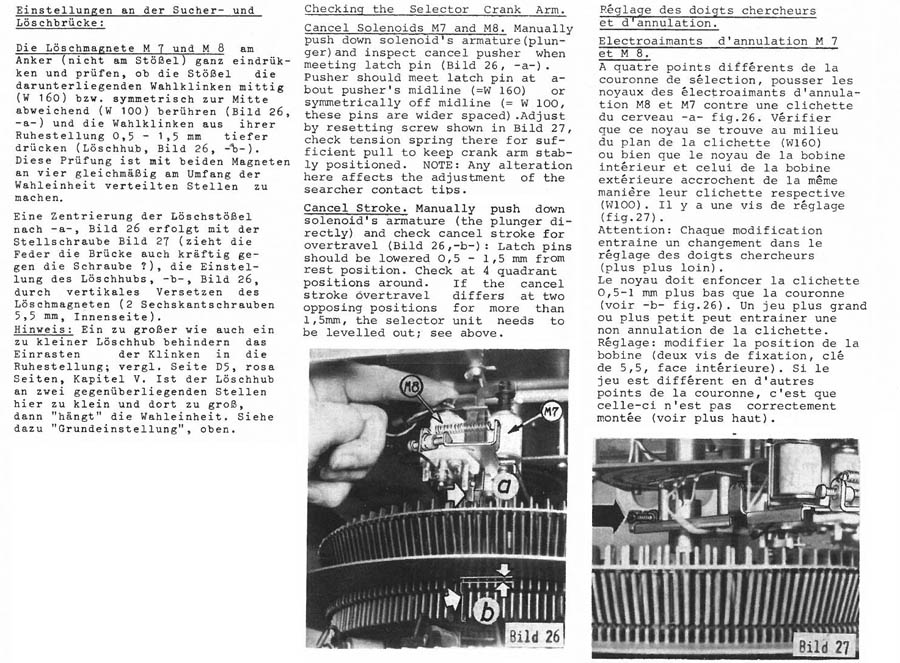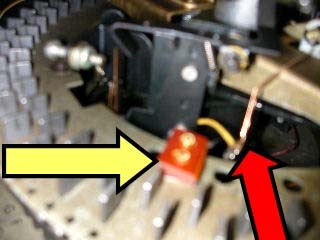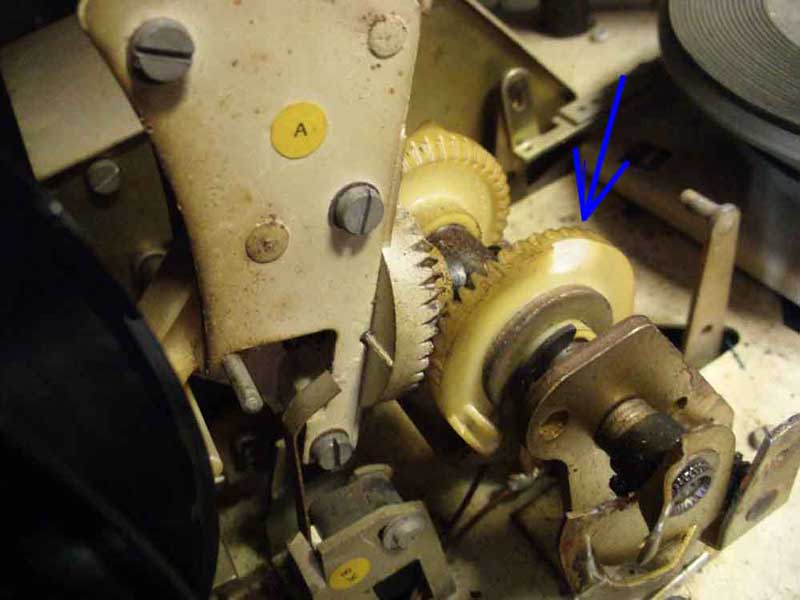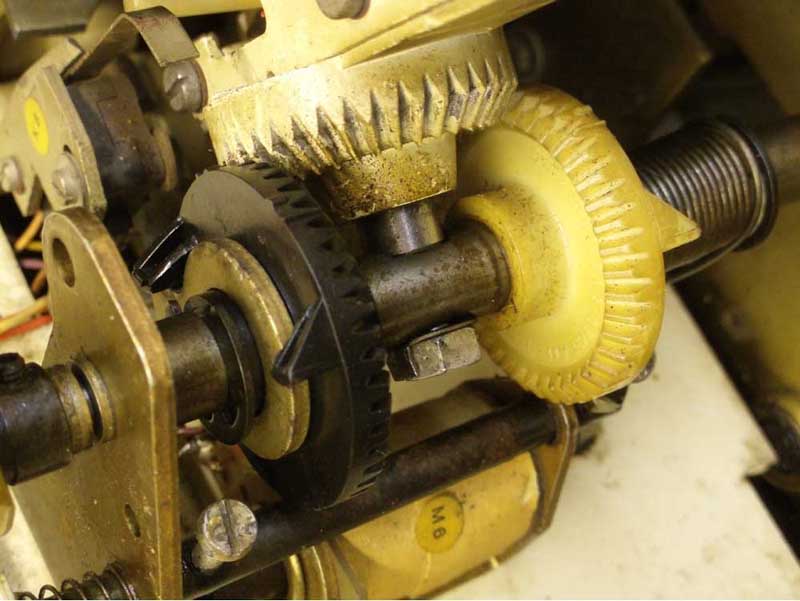|
Bei meiner
Lyric F mit senkrechter Abspielung habe ich folgendes Problem:
ich kann Kredit geben, eine Wahl tätigen und der Mechanismus fährt bis
zur Platte, greift sie und spielt sie ab. Nach Plattenende kann es sein,
dass die Platte erneut gespielt wird, obwohl die Wahl (Klinke) korrekt
zurückgesetzt wurde. Auch kann es vorkommen, dass, wenn der Mechanismus
zur Plattenwahl dreht, einfach zwischendurch wahllos eine Platte
gespielt wird.
Ich habe alle Kontakte gesäubert und mir ist aufgefallen, dass, wenn ich
ohne eine Wahl und ohne Kredit den Plattenkorb langsam mit der Hand
drehe, auch eine Platte gespielt wird. Soweit ich das kenne, fülle ich
die Platten immer, indem ich den Korb drehe, und noch niemals wurde
dabei eine Platte gespielt.
Meines Erachtens dürfte beim Drehen des Korbes nichts ausgelöst werden. Antwort:
An der Löschbrücke (so nennt man die zwei Fühler über den
Klinkenkränzen) befindet sich ein sog. Umfahrschalter.
Bleibt beim normalen Ablauf ein Fühler vor einer hochgeschossenen Klinke
hängen, dann dreht sich die Achse, an dem sich der Plattenkorb und eben
auch die Löschbrücke befindet, noch ein kleines Stückchen weiter.
Zwischen Achse und Löschbrücke wird dabei der Umfahrschalter betätigt.
Der Umfahrschalter ist am leichtesten daran zu erkennen, dass er mit einem
mechanischen Verzögerungszylinder kombiniert ist. (Sieht aus wie ein
kleines rotes Fässchen, aus dem oben ein (schwergängiger) Hebel ragt,
der mit dem eigentlichen Hebel des Umfahrschalters verbunden ist.)
Dieser Umfahrschalter hat die Aufgabe, den Motor der Wechslermechanik (ein
Gleichstrommotor) umzupolen, so dass er in die entgegen gesetzte
Richtung läuft. Damit treibt er nämlich nicht mehr den Plattenkorb und
die Löschbrücke an, sondern eine Nockenscheibe, die letztendlich das
Löschen der Klinke und das Auf und Ablegen der Schallplatte steuert.
Wenn man zum Beispiel (bei einer funktionierenden Box) ohne dass eine
Klinke geschossen wurde, mit der Hand gegen einen der Fühler drückt, so
als ob der Fühler vor einer hochgeschossenen hängen geblieben wäre,
dann löst das das Auf- und Ablegen der Schallplatte aus, die sich
momentan gerade links oder rechts neben dem Plattenspieler befindet.
Aufgrund deiner Fehlerbeschreibung vermute ich also, dass dieser
Umfahrschalter einen "Wackelkontakt" hat, so dass er
manchmal nicht mehr zurückschaltet, und die soeben gespielte Platte
sofort wieder aufgelegt wird.
Oder, wenn er doch nach dem Löschen der Klinke wieder korrekt öffnet und
den Motor wieder auf die Suchlaufrichtung zurückpolt, er durch eine
leichte Erschütterung beim Suchlauf auf einmal wieder den Motor in die
Platten-Aufleg-Rechtung umpolt, und die Platte, die sich jetzt gerade
zufällig neben dem Plattenspieler befindet, auf gelegt wird. 1. Zwischenbericht:
Beim genaueren Suchen habe ich Teile einer Kontaktfeder gefunden (gelber
Pfeil im nachfolgenden Foto), die lagen in der Musikbox. Beim weiteren Betrachten habe ich einen
losen Federkontakt (roter Pfeil) an einem gelben Kabel, welches von der
Löschbrücke kommt, unterhalb der Achse, weit unter der Löschbrücke
gefunden. Ich weiß aber nicht so recht, wo der Kontakt hingehört. Ich
habe ihn zum Fotografieren hochgezogen, denn da unten wo er war, hätte
ich kein Bild machen können. |
|
I have the following problem with my
Lyric F
with vertical play:
I can establish credit, make a selection and the mechanism scans
to the record, takes it and plays it. At the end of the record,
the record may be played again even though the selection (latch
pin) has been reset correctly. It can also happen that while the
mechansim scans to the next selection, a record is simply played
randomly in between.
I have cleaned all contacts and I have noticed that if I turn
the record basket slowly by hand without a selection and without
credit, any record gets also played. As far as I know, I always
insert the records by turning the basket, and no record has ever
been played.
In my opinion, nothing should be triggered when the basket is
turned.
Answer:
There is a so-called reversing switch on the selector crank
(this is the name given to the two sensors above the selector
unit).
If, during normal operation, a sensor gets stuck in front of a
raised latch pin, the axle on which the record magazin and also
the selector crank are located rotates a little further. The
reversing switch is then actuated between the axle and the
selector crank.
The reversing switch is most easily recognized by the fact that
it is combined with a mechanical delay cylinder. (It looks like
a small red barrel with a (stiff) lever protruding from the top,
which is connected to the actual lever of the reversing switch).
This reversing switch has to reverse the polarity of the motor
of the changer mechanism (a DC motor) so that it runs in the
opposite direction. This means that it no longer turns the
record magazin and the selector crank, but a cam disc which
ultimately controls cancelling of the latch pin and loading and
unloading the record.
For example, if you push your hand against one of the sensors
(on a functioning jukebox) without a latch pin being activated,
as if the sensor had got stuck in front of a record that had
been selected, this triggers the record being currently to the
left or right of the turntable to be put on and off.
Based on your
fault description, I guess that this reversing switch has a
loose contact, so that it sometimes no longer downshifts and the
record that has just been played is immediately placed on again.
Or, if it does open correctly again after cancelling the latch
pin and switches the motor back to the search direction, a
slight vibration during the search may suddenly switch the motor
back to the record play direction and the record that happens to
be next to the turntable is being placed on and played.
1st progress
report:
On closer inspection, I found parts of a contact spring (yellow
arrow in following photo) lying in the box. On further
inspection, I found a loose spring contact (red arrow) on a
yellow cable coming from the selector crank, underneath the axle,
far below the selector crank. However, I don't really know where
the contact belongs. I pulled it up to take a photo, because
down where it was located I wouldn't have been able to take a
picture.
|
|
Antwort:
Je nachdem, um welches Baujahr es sich handelt, gibt es lt. Service
Manual Lyric 1962-1969 Fig. 34 verschiedene Ausführungen des
Umfahrschalters. Die
Lyric M 1964 hat noch den Mikroschalter mit Verzögerungszylinder. Für
die späteren Modelle wie die o.g. Lyric F gab es zwei verschiedene
Ausführungen von Kontaktfedersätzen.
Auf dem Foto ist die Schraube links hinten, die auf die Kontaktfeder
zeigt, der Umfahrschalter. Er hat die Aufgabe, den Kontakt zur Masse
herzustellen.
Das andere Ende des gelben Kabel wird also wohl zum Umfahrschalter
hinführen. Wenn der schließt - also in dem Moment, in dem der Fühler
gegen eine hochgeschossene Klinke stößt, stellt er korrekterweise den
Masseschluss her.
Das Problem wird vermutlich das andere Ende des gelben Kabels sein (das,
was Du hochgezogen hast).
Dabei dürfte es sich um den Schleifkontakt handeln, der letztendlich den
Kontakt zum Umschaltrelais herstellt. (Das ist letztendlich bei dem
Hebel, an dem das andere Ende des Seils von der Nadelbürste endet.)
Lange Rede kurzer Sinn: dieser Schleifkontakt gehört korrekterweise
irgendwo da unten hin, wo du ihn hochgezogen hast. Er war wohl die ganze
Zeit schon etwas lose und hat selbsttätig dann und wann einen
Masseschluss hergestellt, was zum plötzlichen und zufälligen Auflegen
einer Platte führte.
Der Schleifkontakt wird logischerweise deshalb benötigt, weil man ja kein
festes Kabel vom Umschaltrelais zum Umfahrschalter an der (sich immer
mit dem Plattenkorb drehenden) Löschbrücke legen kann. Ist er jedoch
lose, kann der Umfahrschalter natürlich überhaupt nicht mehr in Funktion
treten.
Deshalb ist es WICHTIG, keine Platte mehr zu wählen,
bevor der Schleifkontakt nicht wieder richtig hergestellt ist. Der
Wechslermotor drückt ansonsten den Fühler endlos gegen die
hochgeschossene Klinke. Die ganze Mechanik würde sich verbiegen und Schaden nehmen, oder der Wechslermotor und das Getriebe
kaputt gehen.
Denn durch den fehlenden Schleifkontakt kann der Motor nicht mehr in die
Gegenrichtung umgeschaltet werden.
Am unteren Ende der Achse von Plattenkorb und Löschbrücke müsste nach Fig.
34 aus dem Service Manual, eine viereckige Platte sein, an der der
Schleifkontakt befestigt war. Er wird dann wohl auf der darunter
liegenden Platte auf einer bestimmten Spur gekreist sein, wenn sich der
Plattenkorb und die Löschbrücke drehen.
Also sofern Du es noch nicht hast, am besten das
entsprechende
SERVICE MANUAL hier im Shop besorgen. Ein genereller Hinweis:
beim Auseinandernehmen kann es hilfreich sein, jeden Schritt mit
Fotos zu dokumentieren. So weiß man im Nachhinein, wie es wieder
zusammen gehört.
Lösung:
Es lag am Umkehrschalter. Von dem geht ein Kabel an einen Schleifer,
welcher unterhalb der Löschbrücke auf einem runden Metallteil schleifen
soll. Dieser Schleifer hatte leider alle Kontaktnieten verloren, war
deshalb auseinander gefallen und lag lose in der Musikbox. Da der Kontakt
dennoch ab und zu an Masse kam, lief die Musikbox wohl mit dem bekannten
Problem. Jetzt habe alles wieder am rechten Platz eingebaut und siehe
da, es ist perfekt!
|
|
Answer:
According to the Service Manual Lyric 1962-1969 Fig. 34,
there are different versions of the reversing switch depending
on the year of manufacture. The
Lyric M 1964 still has the
microswitch with delay cylinder. For the later models such as
the Lyric F mentioned above, there were two different versions
of contact spring sets.
In the photo,
the screw on the rear left pointing to the contact spring is the
reversing switch. Its function is to make contact with ground.
The other end of the yellow cable will therefore probably lead
to the reversing switch. When it closes - i.e. at the moment
when the sensor hits a raised latch pin - it correctly
establishes the ground connection.
The fault will probably be the other end of the yellow cable (the
one you have pulled up). This is probably the sliding contact
that eventually makes contact with the changeover relay. (This
is eventually at the lever where the other end of the cable from
the needle brush ends).
Long story
short: This sliding contact correctly belongs somewhere down
where you pulled it up. It has probably been a little loose all
the time and has automatically produced a short to ground every
now and then, which led to the sudden and accidental placement
of a record.
The sliding contact is logically required because you cannot lay
a fixed cable from the changeover relay to the reversing switch
on the selektor crank (which always rotates with the record
magazin). However, if it is loose, the reversing switch can of
course no longer function at all.
It is therefore IMPORTANT not to select any more records
until the sliding contact has been correctly re-established.
Otherwise, the changeover motor would press the sensor endlessly
against the raised latch pin. The entire mechanism would bend
and be damaged, or the changer motor and the gearbox would break.
This is because the motor can no longer be switched in the
opposite direction due to the missing sliding contact.
According to Fig. 34 in the service manual, there should be a
square plate at the lower end of the axle of the record magazin
and the selector crank to which the sliding contact was attached.
It will then probably have circled on the plate underneath on a
certain track when the record magazin and the selector crank
rotate.
So if you
don't already have it, it's best to get the corresponding
SERVICE MANUAL here in the store. A general tip: When taking
something apart, it can be helpful to document each step with
photos so that you know how to put it back together again
afterwards.
Solution:
It was the troublesome reversing switch. From this a wire goes
to a wiper which is supposed to slide on a round metal part
underneath the selector crank. Unfortunately, this wiper had
lost all its contact rivets, had therefore fallen apart and was
lying loose in the jukebox. As the contact did still get contact
to earth from time to time, the jukebox was probably running
with the explained problem. Now I've put everything back into the
right place and it's perfect!
|




